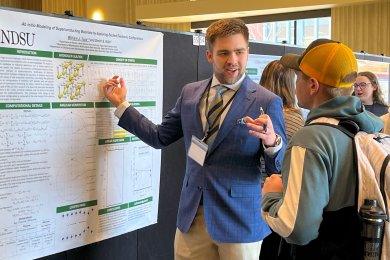Four NDSU researchers have received a three-year $1.9 million grant from the Department of Energy for a project titled “Data-Driven and Computationally Assisted Design of Near-Infrared Emissive Metal-Organic Complexes with Earth-Abundant Metals.”
The researchers and principal investigators include Svetlana Kilina, James A. Meier Associate Professor of chemistry and biochemistry; Dmitri Kilin, associate professor of chemistry and biochemistry; Wenfang Sun, Gehrts Professor of chemistry and biochemistry; and Bakhtiyor Rasulev, assistant professor of coatings and polymeric materials.
According to Kilina, metal-organic complexes are molecules consisting of a metal ion center surrounded by organic ligands. The structure is responsible for appealing optical properties:
• They can emit light for very long time (phosphorescence, involving change in electronic spin)
• The color (energy) of the emitted light and its intensity can be easily tuned via chemical modifications of substituting groups of the ligands.
This class of materials has shown potential for various optoelectronic applications and, in particular, can serve as light emitters in the near-infrared region that can be used for night vision and deep tissue penetration.
However, most of current metal-organic light emitters use precious metals such as platinum, ruthenium and iridium, which are expensive and limited in natural supplies.
“This project proposes to achieve highly efficient long-lived near-infrared region emission, important for night-vision and telecommunication devices, optical sensing, photocatalysis, and bioimaging using new metal-organic complexes involving earth abundant metals copper, tungsten and molybdenum,” Kilina said. “A rational design of the metal-organic complexes with improved emission properties is challenging because the relationship between the geometrical structure and emission features is not fully understood. To optimize the emission characteristics, numerous possibilities of ligand combinations should be checked, which is a great challenge for conventional experimental approaches. Instead of tedious experimental studies to figure out the best ligand combinations, this project aims to develop methodology that combines experimental data and computational results with data-driven analysis based on machine learning and cheminformatic models, which are also called artificial intelligence.”
The predicted criteria will be used to guide the design of novel near infrared region-active earth-abundant metal-organic complexes with copper, tungsten and molybdenum metals.
The NDSU project is one of 13 across the nation to receive funding as part of part of competition for research in critical minerals and materials sponsored by the Office of Basic Energy Sciences. The research efforts will advance basic chemical and materials sciences that impacts the isolation of critical elements from natural and recycled resources to minimize supply risks while identifying substitutes to reduce or eliminate the need for critical elements without losing desired functionalities.
The 13 research projects are led by 10 universities and three National Laboratories. Total funding is $30 million from DOE’s Office of Science for projects lasting up to three years in duration, with $10 million in fiscal 2021 dollars.
As a student-focused, land-grant, research university, we serve our citizens.



